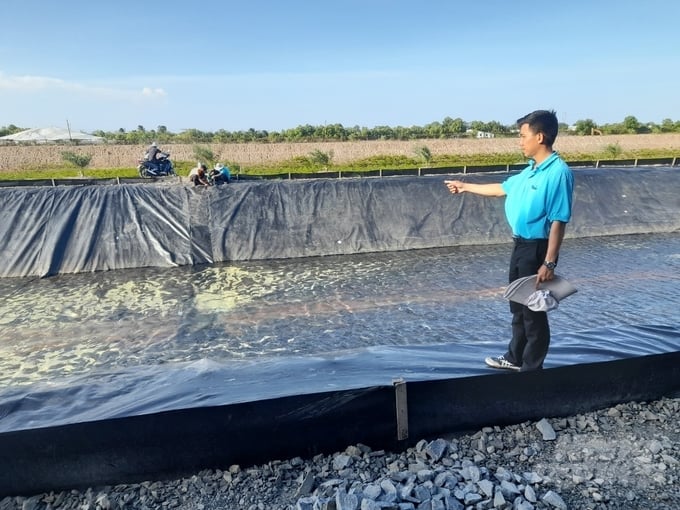November 28, 2025 | 04:19 GMT +7
November 28, 2025 | 04:19 GMT +7
Hotline: 0913.378.918
November 28, 2025 | 04:19 GMT +7
Hotline: 0913.378.918

Farmers breeding white-leg shrimp in Duyen Hai district (Tra Vinh province) are inspecting their ponds. Photo: Ho Thao.
The two-stage model for farming whiteleg shrimp utilizing 4.0 technology includes arranging nursery ponds, settling ponds, wastewater treatment ponds, and grow-out ponds with an area of 1,500 m2/pond and stocking density of 200 shrimp/m2.
Advantages of the model include shading nets covering the ponds with 65% shading, installation of paddlewheel, water pump, bottom aeration system, as well as automatic monitoring and environmental alert system. Biogas digesters are used for collecting and treating waste, reducing water pollution. Thanks to this system, shrimp farmers can promptly address unfavourable factors through automatic monitoring of dissolved oxygen levels, temperature, pH, and salinity in the ponds.
The technical shrimp farming process spans two stages. In the first month, shrimp are entirely nursed indoors in greenhouses for better management and care, achieving a survival rate of 100%. The second stage starts in the second month, shrimps are moved to grow-out ponds, with an average survival rate exceeding 94%.
After about 70 - 75 days of farming, shrimp reach an average size of 55 shrimp/kg, equivalent to a yield of over 34 tons/ha/crop. If market prices for commercial-grade shrimp (size 55 shrimp/kg) reach between VND 120,000 - 130,000/kg, after deducting costs, profits can reach approximately VND 1 - 1.5 billion/ha/crop.
Mr. Le Van Dong, Deputy Director of the Department of Agriculture and Rural Development of Tra Vinh province, mentioned that the model is currently supported technically by the provincial agriculture sector and encouraged for implementation among farmers with suitable conditions. As of mid-June 2024, the area for high-tech whiteleg shrimp farming in the province has reached over 1,440 ha, with over 1.53 billion shrimp seedlings stocked, marking a 2.26-fold increase compared to the same period in 2023.
Translated by Hoang Duy

(VAN) On November 27, in the meeting with Minister Tran Duc Thang, Mayor Yin Yong shared Beijing’s experience to improve environment and air quality.

(VAN) After 30 years, both sides identified strategic areas of cooperation: sustainable production, increasing coffee value and training for farmers.
/2025/11/27/4910-4-164708_294.jpg)
(VAN) On the afternoon of November 27 in Beijing, Minister of Agriculture and Environment Tran Duc Thang held a working session with several major Chinese enterprises operating in the agriculture and environment sector.

(VAN) The Department of Animal Health issued a provisional guideline requesting local authorities to increase surveillance, collect samples for testing, and conduct epidemiological investigations according to the established procedure.

(VAN) The United Nations recommends that Vietnam utilize data and artificial intelligence to enhance early disaster warnings and reduce GDP losses by 3.2% in the context of climate change.

(VAN) On the morning of November 27 in Beijing, Minister Tran Duc Thang and the Deputy Commissioner General of the General Administration of Customs of China signed a protocol on fresh jackfruit exports.

(VAN) As floodwaters recede, a vast network of irrigation works across eastern Gia Lai is emerging in a state of severe disrepair, with extensive damage demanding urgent restoration ahead of the 2025-2026 winter-spring cropping season.